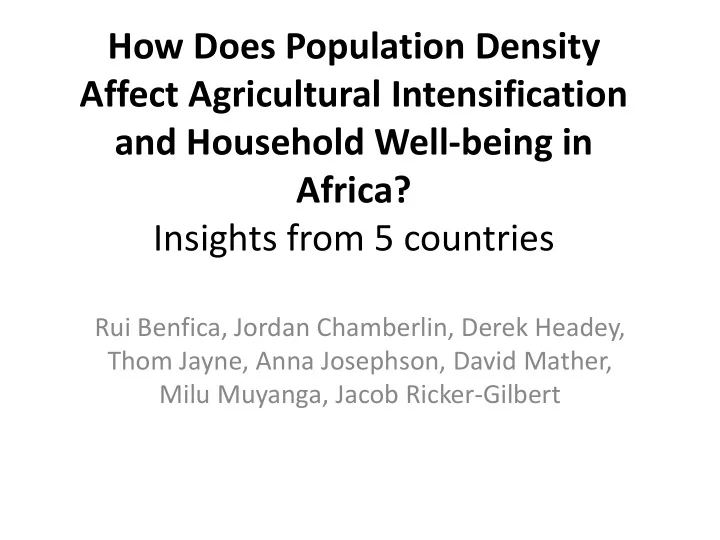

How Does Population Density Affect Agricultural Intensification and Household Well-being in Africa? Insights from 5 countries Rui Benfica, Jordan Chamberlin, Derek Headey, Thom Jayne, Anna Josephson, David Mather, Milu Muyanga, Jacob Ricker-Gilbert
Why does Population Density Matter? • Population in SSA expected to grow by 500 million in next 20 years. • Many rural households live in areas of relatively high population density. • large tracts of un-used land in many countries. • What does this mean for agriculture and food security? Kenya Zambia 2
Descriptive evidence reveals that larger farms have higher incomes. ETHIOPIA KENYA RWANDA 6.2 9.8 4.4 ) e 4.2 m 5.8 9.4 o 4.0 c n I 3.8 9.0 5.4 a 0 .25 .5 .75 1 0 .25 .5 .75 1 0 .25 .5 .75 1 t Ha Ha Ha i p a MOZAMBIQUE ZAMBIA 4.0 3.8 C r e 3.6 P 3.5 ( 3.4 g o 3.0 L 3.2 0 .25 .5 .75 1 0 .25 .5 .75 1 Ha Ha Per Capita Land Access (Ha) Relationships between farm size and household income 3
Boserupian theory predicts that population density drives intensification Research questions: 1) Through what channels does population density drive intensification? 2) What are the constraints to smallholder intensification in areas of high population density? 3) Is there a population density threshold beyond which farmers are no longer able to intensify production? 4
Pathways Through which Population Density Affects Household Outcomes observed unobserved observed observed INDIRECT EFFECTS Land prices Landholding Non-market institutions Input demand Output prices Population Output density supply Wage rates Income Information flow, Institution development, Transaction costs DIRECT EFFECTS 5
Household Intensification Under Population Density t + P t β + ρL it + X it 𝜖 + c i + v it Y it = α 1 D t + α 2 D 2 Y: Outcome measure of interest D: population density and its square. P : factor and output prices L: landholding X : other household, and community factors c: unobserved time-constant effects v: unobserved time-varying effects � 𝟐 , α � 𝟑 = 0, tests the direct effect of pop den on Y H 0 : α 6
Indirect Partial Effect + Total Partial Effect Landholding (farm size) t + M it 𝜖 + μ it L it = η 1 D t + η 2 D 2 Prices t + Z it 𝜖 + ε it P it = ζ 1 D t + ζ 2 D 2 Calculating Total Effect (combine D and D 2 ) Y it = α D t + (D t ) P it β + ρL it (D t ) + X it 𝜖 + c i + v it Total Partial Effect 𝜖Y it 𝜖D t = 𝜖Y it 𝜖D t + 𝜖Y it 𝜖P it ∗ dP it dD t + 𝜖Y it 𝜖L it ∗ dL it dD t = or TOTAL EFFECT DIRECT EFFECT + INDIRECT EFFECT 𝜖Y it � ( ζ 1 + 2 ζ 2 D t ) + ρ 𝜖D t = α � + β � ( η 1 + 2 η 2 D t ) 7
Is population density endogenous? • Maybe – Due to omitted variables – Or due to reverse causality • correlation between covariates and unobserved heterogeneity c i controlled for using the correlated random effects (CRE) estimator. � δ + a i ; where a i = (o, σ 2 ) c i = Ψ + 𝑌 𝑗 • Some countries used IV methods with control function approach. 8
Estimation Procedure • All models estimated linearly. • Pooled CRE • Estimate via Seemingly Unrelated Regression (SUR). – Models are linked through their error terms, so allows us to directly compute total partial effects. – Efficiency gain over equation-by-equation. 9
Case Studies Ethiopia Kenya Zambia Malawi Mozambique “Land abundance” “Land constrained” (high land/labor ratios) (low land/labor ratios) 10 10 Zambia Northern Mozambique Southern Malawi Kenya
Gridded Population Data • High-resolution gridded estimates of rural population distributions – GRUMP (Global Rural-Urban Mapping Project, Balk and Yetman 2004) – AfriPop project (Linard et al. 2012) • Significant improvements over earlier databases – input statistical data are at fairly high levels of disaggregation – reporting units further disaggregated spatially 11
12
13
14
INDIVIDUAL COUNTRY CASE STUDIES 15
Recommend
More recommend